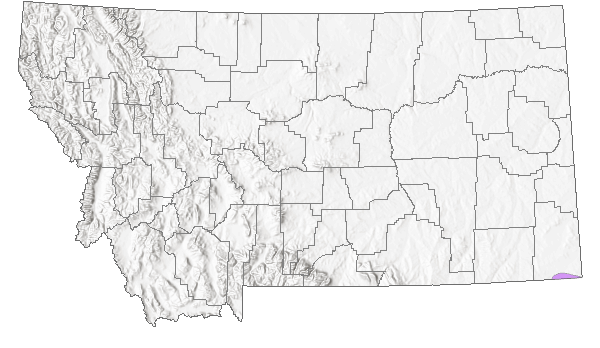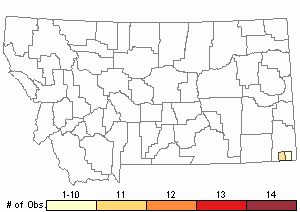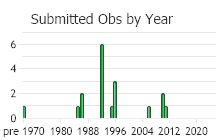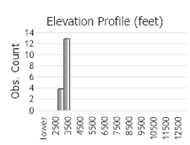View in other NatureServe Network Field Guides
NatureServe
Montana
Utah
Wyoming
Idaho
Wisconsin
British Columbia
South Carolina
Yukon
California
New York
Bur Oak - Quercus macrocarpa
State Rank Reason (see State Rank above)
Bur oak is at the extreme western edge of its range in Montana, where it occurs in a localized, though fairly large, occurrence in Carter County. Bentonite mining is active in this area and exotic weeds are prevalent though negative impacts to bur oak have not been documented due to a lack of surveys and monitoring.
- Details on Status Ranking and Review
Population Size
Score1 - Moderate: Generally 10,000-100,000 individuals.
Range Extent
Score1 - Peripheral, Disjunct or Sporadic Distribution in MT: Widespread species that is peripheral, disjunct or sporadically distributed within MT such that it occurs in <5% of the state (<7,500 sq. miles or the combined area of Beaverhead and Ravalli Counties) or is restricted to 4-5 sub-basins.
Area of Occupancy
Score3 - Very Low: Generally occurring in 3 or fewer Subwatersheds (6th Code HUC’s).
Environmental Specificity
Score2 - High: Species is restricted to a highly specialized and limited habitat and is typically dependent upon unaltered, high-quality habitat (C Values of 8-10).
Trends
Score1-3 - Declining: Species is likely declining though the magnitude of declines is uncertain. Declines may be based upon range extent and/or occupied area in the recent past (approximately 30 years).
CommentTrends are unknown, though may be declining due to impacts to habitat quality from invasive species and due to impacts related to bentonite mining. Non-native species may be having a negative impact on recruitment and establishment of he oak.
Threats
Score3 - Very High: >70% of the populations are being negatively impacted or are likely to be negatively impacted in the near future by one or more activities or agents that are expected to result in decreased populations and/or decreasing habitat quality and/or quantity.
Intrinsic Vulnerability
Score1 - Moderate Vulnerability: Specific biological attributes, unusual life history characteristics or limited reproductive potential makes the species susceptible to extirpation from stochastic events or other adverse impacts to its habitat and slow to recover.
Raw Conservation Status Score
Score
12 to 14 total points scored out of a possible 19.
General Description
Monoecious trees to 10 m with gray, scaly bark. Twigs pubescent, often with corky wings. Leaves alternate, simple, petiolate; the blades obovate, 6–15 cm long, pinnately lobed, the lobes rounded with wavy margins. Flowers unisexual with a 6-lobed perianth. Male flowers borne in a drooping, interrupted, spike-like inflorescence; perianth 6-lobed with 6 to 10 stamens. Female flowers in clusters of 1 to 3; the perianth adnate to the ovary, surrounded by a scaly, cup-like involucre; pistil 1 with 3 styles. Fruit a hardened, ovoid nut (acorn) 15–50 mm long, surrounded at the base by the hardened, cup-like, scaly and hairy involucre (
Lesica et al. 2012. Manual of Montana Vascular Plants. BRIT Press. Fort Worth, TX).
Phenology
Flowering takes place in spring, and acorns mature in one year.
Diagnostic Characteristics
Bur oak is Montana's only native oak.
Species Range
Montana Range
Range Descriptions

 Native
Native
Range Comments
In MT bur oak is restricted to the extreme southeastern corner of the state in Powder River and Carter counties(Vanderhorst et al. 1998; Lesica 2012); eastern temperate N. Am., in Canada from SK to NB, central U.S. south to TX, east to ME and AL (Nixon and Muller 1997 in Fl. N. Amer. Vol. 3).
Observations in Montana Natural Heritage Program Database
Number of Observations: 21
(Click on the following maps and charts to see full sized version)
Map Help and Descriptions
Relative Density

Recency



 (Observations spanning multiple months or years are excluded from time charts)
(Observations spanning multiple months or years are excluded from time charts)
Habitat
Most locations are on bentonitic shale ridges trending WNW to ESE and extending into Wyoming (Vanderhorst et al. 1998). Bur oak forms solid or mixed stands on slopes, and is widely scattered in a savanna-like association on the ridgetops. It co-dominates in various proportions with Rocky Mountain juniper (Juniperus scopulorum) and ponderosa pine (Pinus ponderosa). The understory is relatively depauperate, even under full canopy cover, and there is a high diversity of annuals, including Nuttallanthus texanus, and a high proportion of exotic grasses and forbs. Openings are often dominated by the rhizomatous sedge, Carex inops (C. heliophila), with shrubs confined to the more wooded stands.
A secondary habitat is the alluvial terraces along the Thompson Creek tributary of the Little Missouri River, where bur oak is the dominant tree or is occasional in stands of green ash (Fraxinus pennsylvanica). The understory of these habitats is dominated by introduced pasture grasses, and in many places, a near monoculture of Bromus inermis.
Ecology
Bur oak is a member of the white oak group. It is a slow-growing, long-lived tree capable of living 200-300 years and it can reproduce both vegetatively and sexually. Wnd is the primary means of pollination.
Acorns mature in one year and are typically produced in abundance every two to three years. However, consumption of acorns by wildlife can significantly reduce numbers available for germination. Leaves of bur oak may be used as forage by cattle and mule deer and are most vulnerable to herbivory after they emerge, when the concentration of tannins and phenols is lowest. Galls are common and leaf-mining occasional; heart rot was noted in one tree cored along the Little Missouri River and suspected in trees on the ridge slope.
Fire historically played an important role in maintaining stands of Quercus macrocarpa throughout its geographic range (Abrams 1992). Bur oak will resprout from a damaged trunk. Prescribed fire was found to increase the number of bur oak sprouts in stands in the Black Hills but did not increase the density of seedlings (Sieg and Wright 1996). Minimum seed-bearing age for bur oak has been reported to be 35 years.
Management
The "Alzada Oaks" constitute Montana's only known stand of bur oak, and the stand lies at the westernmost edge of the species' natural range. They have been affected by mining, associated road construction and maintenance, and grazing (Vanderhorst et al. 1998). The long history of grazing by sheep and horses and the harsh environment at the site favor high numbers of introduced species and a relatively impoverished native flora (Heidel 1993). Competition from weeds may limit the establishment and growth of bur oak. Bur oak provides forage for cattle and mule deer though effects of grazing on the the Montana population are not known. Fire may have played a role in maintaining Q. macrocarpa by reducing competition from non-stump sprouters such as ponderosa pine and juniper, and suppression of wildfire may be having an adverse effect on Q. macrocarpa recruitment.
Threats or Limiting Factors
STATE THREAT SCORE REASON
Reported threats to Montana's populations of Bur Oak are due to ongoing bentonite mining in the vicinity of most populations. Bur Oak populations at the extreme edge of its range are clustered where demand for bentonite is also concentrated. Thus, negative impacts to this very limited habitat are potentially severe (MTNHP Threat Assessment 2021).
References
- Literature Cited AboveLegend:
 View Online Publication
View Online Publication Lesica, P., M.T. Lavin, and P.F. Stickney. 2012. Manual of Montana Vascular Plants. Fort Worth, TX: BRIT Press. viii + 771 p.
Lesica, P., M.T. Lavin, and P.F. Stickney. 2012. Manual of Montana Vascular Plants. Fort Worth, TX: BRIT Press. viii + 771 p.
- Additional ReferencesLegend:
 View Online Publication
View Online Publication
Do you know of a citation we're missing? Abrams, M. D. 1992. Fire and the development of oak forests. BioScience 42(5):346-353.
Abrams, M. D. 1992. Fire and the development of oak forests. BioScience 42(5):346-353. citation currently unavailable in central databases; housed at Heritage program
citation currently unavailable in central databases; housed at Heritage program Girard, M. M., H. Goetz, and A. J. Bjugstad. 1989. Native woodland habitat types of southwestern North Dakota. USDA Forest Service, Rocky Mountain Forest and Range Experiment Station. Research Paper RM-281. Fort Collins, CO. 36 pp.
Girard, M. M., H. Goetz, and A. J. Bjugstad. 1989. Native woodland habitat types of southwestern North Dakota. USDA Forest Service, Rocky Mountain Forest and Range Experiment Station. Research Paper RM-281. Fort Collins, CO. 36 pp. Heidel, B.L. 1993. Survey for Quercus macrocarpa in the Powder River Resource Area, Miles City District, Bureau of Land Management, Montana. Unpublished report to the Bureau of Land Management, Miles City District. Montana Natural Heritage Program, Helena, MT. 13 pp. plus appendices.
Heidel, B.L. 1993. Survey for Quercus macrocarpa in the Powder River Resource Area, Miles City District, Bureau of Land Management, Montana. Unpublished report to the Bureau of Land Management, Miles City District. Montana Natural Heritage Program, Helena, MT. 13 pp. plus appendices. Lesica, P., M.T. Lavin, and P.F. Stickney. 2022. Manual of Montana Vascular Plants, Second Edition. Fort Worth, TX: BRIT Press. viii + 779 p.
Lesica, P., M.T. Lavin, and P.F. Stickney. 2022. Manual of Montana Vascular Plants, Second Edition. Fort Worth, TX: BRIT Press. viii + 779 p. MacCracken, J.G. and D.W. Uresk. 1984. Big game habitat use in southeastern Montana. The Prairie Naturalist 16(3):135-139.
MacCracken, J.G. and D.W. Uresk. 1984. Big game habitat use in southeastern Montana. The Prairie Naturalist 16(3):135-139. Sieg, C. H. 1991. Ecology of bur oak woodlands in the foothills of the Black Hills, South Dakota. Ph.D. dissertation, Department of Range and Wildlife Management, Texas Tech University.
Sieg, C. H. 1991. Ecology of bur oak woodlands in the foothills of the Black Hills, South Dakota. Ph.D. dissertation, Department of Range and Wildlife Management, Texas Tech University. Sieg, C. H. and H. A. Wright. 1996. The role of prescribed burning in regenerating Quercus macrocarpa and associated woody plants in stringer woodlands in the Black Hills, South Dakota. International Journal of Wildlands Fire 6: 21-29.
Sieg, C. H. and H. A. Wright. 1996. The role of prescribed burning in regenerating Quercus macrocarpa and associated woody plants in stringer woodlands in the Black Hills, South Dakota. International Journal of Wildlands Fire 6: 21-29. Vanderhorst, J.P., S.V. Cooper, and B.L. Heidel. 1998. Botanical and vegetation survey of Carter County, Montana. Unpublished report prepared for the Bureau of Land Management. Montana Natural Heritage Program, Helena. 116 pp. + app.
Vanderhorst, J.P., S.V. Cooper, and B.L. Heidel. 1998. Botanical and vegetation survey of Carter County, Montana. Unpublished report prepared for the Bureau of Land Management. Montana Natural Heritage Program, Helena. 116 pp. + app.
- Web Search Engines for Articles on "Bur Oak"





